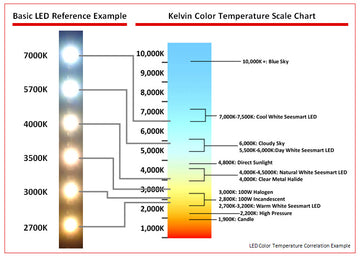
If you've ever wondered why the light in your room looks yellowish or bluish, you're not alone. The color of light is measured in units called Kelvin (K), and this is known as color temperature. Here's what you need to know about color temperature:
-
What is color temperature? Color temperature is a measurement of the hue of a particular light source. It is measured in Kelvin (K), and it ranges from warm to cool. Warm light sources have lower color temperatures, while cool light sources have higher color temperatures.

-
Warm vs cool light Warm light has a yellow or orange hue, while cool light has a blue or white hue. Warm light is often used in settings where a cozy, relaxing atmosphere is desired, such as in living rooms or bedrooms. Cool light is often used in settings where visibility is important, such as in offices or hospitals.
-
Color temperature and lighting design The color temperature of a light source can have a significant impact on the overall design and ambiance of a space. Designers can use warm or cool light sources to create a specific mood or effect, or they can mix warm and cool light sources to achieve a more balanced and natural look.
-
Applications of color temperature Understanding color temperature is important in various fields, including photography, videography, and lighting design. In photography and videography, the color temperature of the light source can affect the color balance of the image or video. In lighting design, the color temperature can affect the overall look and feel of a space.
-
How to measure color temperature Color temperature is measured using a Kelvin (K) scale. A color temperature of 2700K-3000K is considered warm, 3500K-4100K is considered neutral, and 5000K-6500K is considered cool. Some light sources, such as LED bulbs, have adjustable color temperatures, which allows you to customize the lighting to suit your needs.

5. Considerations when choosing lighting When choosing lighting for your home or workspace, it's important to consider the color temperature of the light source. Warm light sources are often used in residential settings, while cool light sources are often used in commercial or industrial settings. Consider the function of the space and the mood you want to create when choosing the color temperature of your lighting.
Color temperature is an important factor to consider when designing or choosing lighting. It can affect the mood, ambiance, and overall look of a space, so it's important to understand how it works and how to use it to your advantage.

